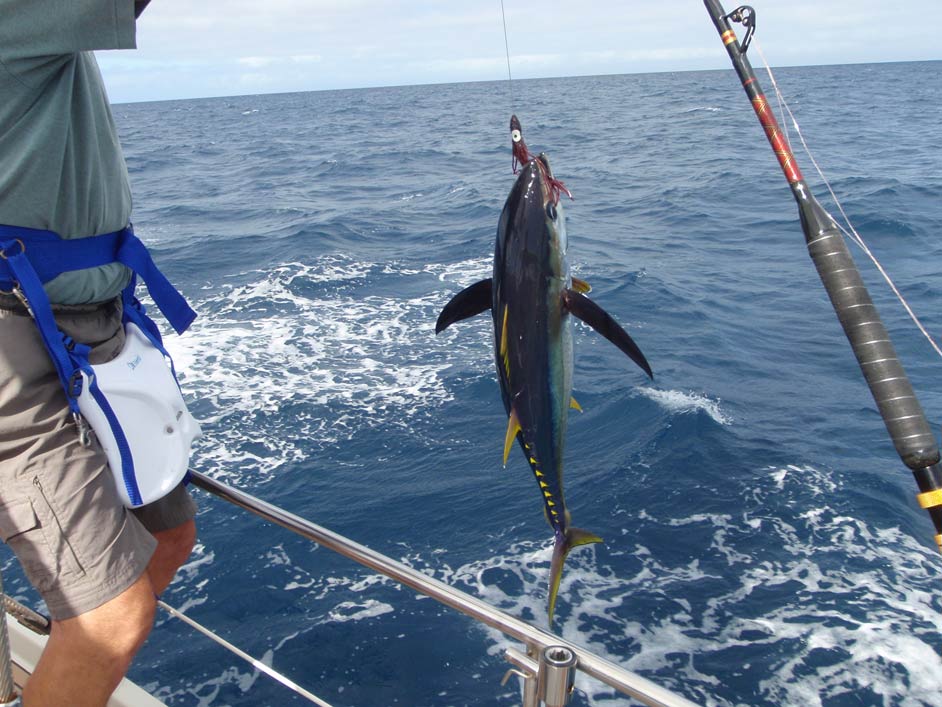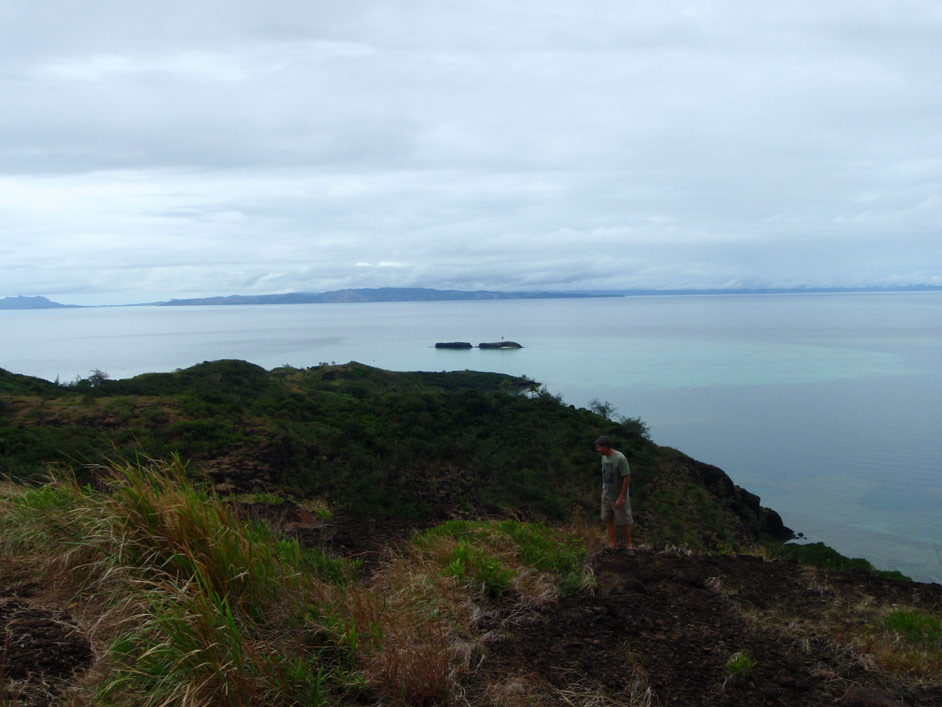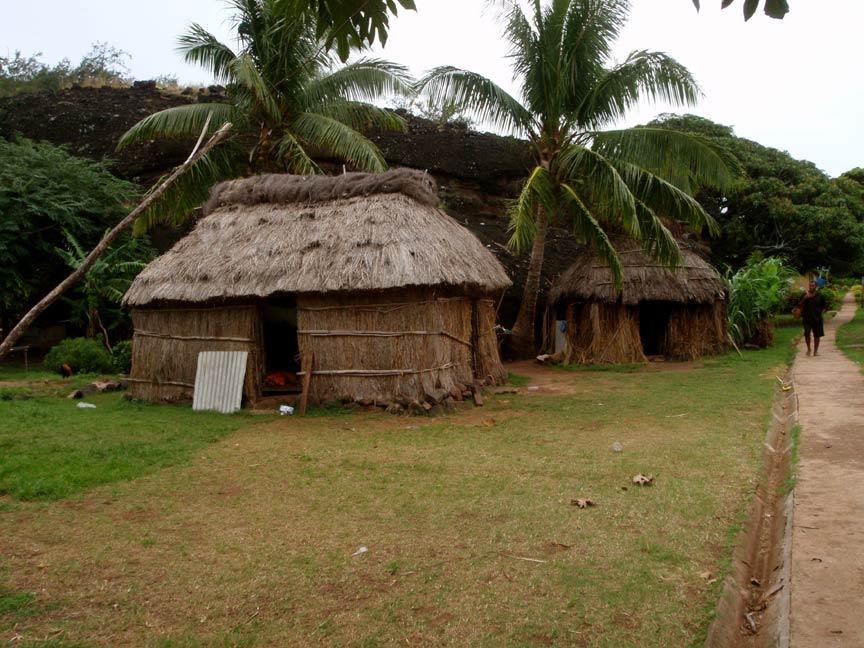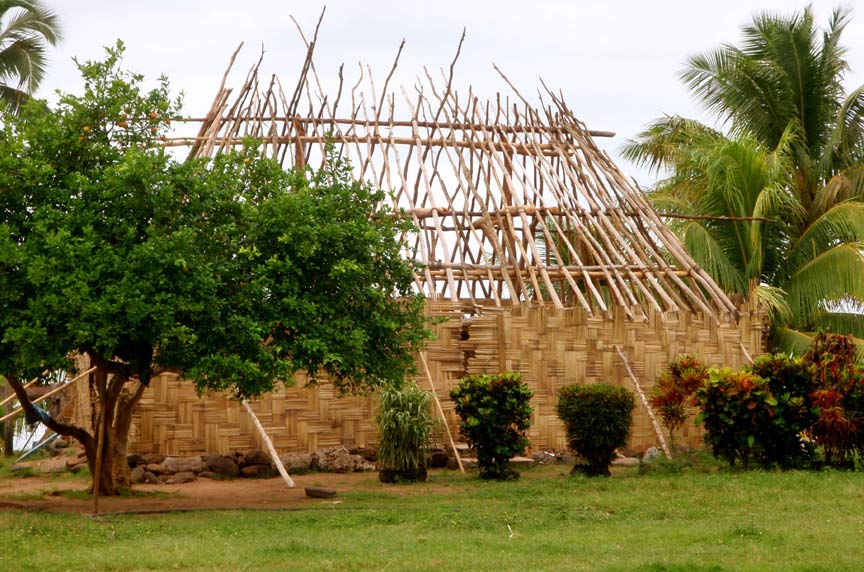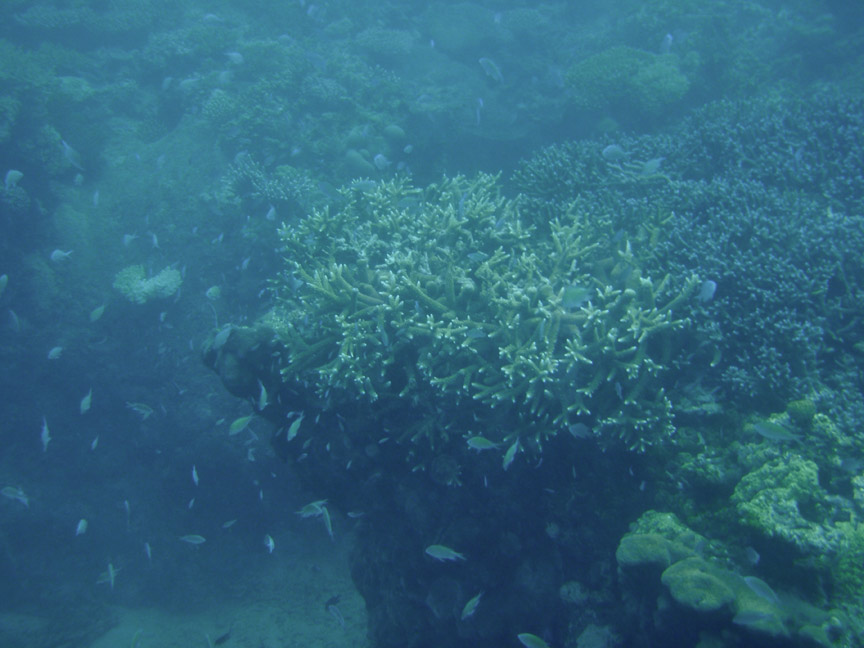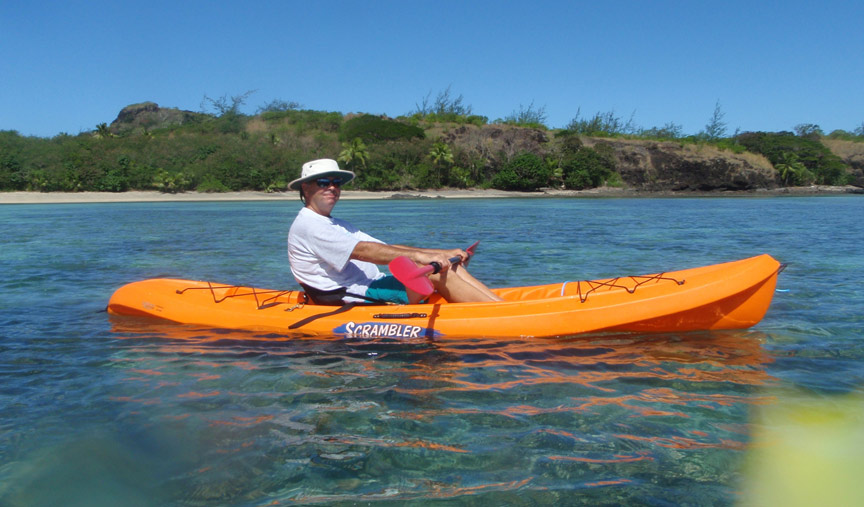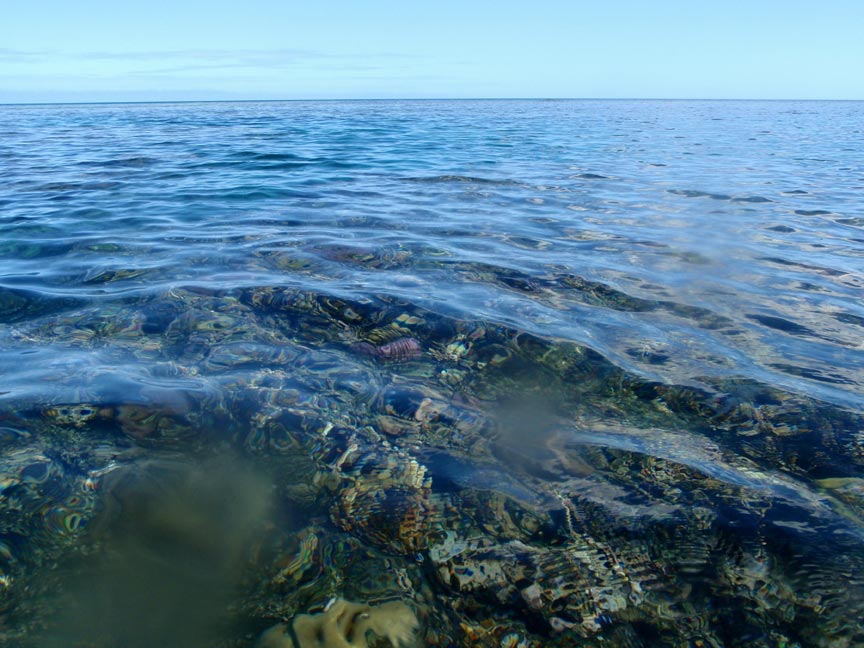Big Wind, Part 1 - Cukuvou Harbor, Yadua Island, Fiji

Harmonie
Don and Anne Myers
Wed 29 Jul 2009 22:59
|
16:49.049S 178:17.022E
Again with the wind. What is it with the wind
this year? We've been asking ourselves that question quite often
lately. In all of our 18,000 miles of travel during Season One, we
only experienced a few short-lived storms with winds up to 42 knots and just
that one ferociously gusty two-day sail from Fiji to Vanuatu. Other
than that? Pleasantly light winds. Not so this season with its
stormy beginnings in New Zealand, nasty little tempests in Tonga and especially
breezy two-day sail to Fiji. The wind stirred itself up into
a fantastic frenzy for us again at Yadua Island. Wait a minute though
- I'm getting ahead of myself - here's the story from the
beginning.
After our three days at Mokogai Island with the
leper ghosts, we set sail with Lady Kay for Yadua Island on July 17th
(Storyteller had visitors to meet at one of the resort islands on the western
side of the big island of Viti Levu, so went on ahead of us). We had
plenty of wind (not to be confused with too much wind) for a speedy 60ish
mile sail to the northwest through lots of reefy areas and channels marked
by nonexistent navigation buoys and markers. Don proved once again
that the old wives tale regarding boat speed and fish catching is not based on
reality. Going eight knots he caught what at first looked like a small
barracuda (long and skinny with black and white stripes and scary-looking teeth
- ugly beast), but after consulting the fish book we determined it was really a
wahoo (still ugly). Back it went into the sea. A short while later,
while still sailing at eight knots, we caught a big tuna. Again after
consulting the fish book, we determined it was a black fin tuna. An
amazing looking creature with a black back, snowy white belly, yellow fins and
the most amazing giant eyes you've ever seen on a fish (see pictures 1 and
2). They looked like the fake eyes of a teddy bear - big and round, very,
very white with black, black irises. The bad thing about fishing for food
is that the fish has to be killed. It's good that Don takes care of this
particular task. At least then the crew only has to endure the
sound of the poor fish's tail as it flaps-flaps on the deck during the
final throes of death. This time our industrial sized double hook was so
firmly lodged in the poor fish's mouth that Don decided to wait until the
creature was dead before attempting to extract it. Unfortunately, in his
zeal to finish the job of cutting, gutting, cleaning and skinning quickly, Don
threw the fish's head overboard with the industrial sized double hook still
lodged in it. 'Shit!!' is what we both said not too long after
the head hit the water. Then we felt pangs of guilt when we thought about
the nasty surprise some larger fish was going to get when it bit down on what it
thought was a fish head gift from heaven and instead got an industrial
sized double hook lodged in its throat. A bit like giving out
candy filled with razor blades on Halloween. Ok, maybe not that
bad; but still, some big fish out there was not going to be
happy. Later, as we approached our destination, Don brought in our
second fishing line only to find that half the lure and the
entire industrial sized double hook assembly was gone. Apparently
some really big fish went for the fake bright green plastic squid and took
the entire industrial sized double hook assembly with it. Stupid
fish. One for two and two that day. Up one tuna, down two
industrial sized double hooks and up two really pissed off big fish with
industrial sized double hooks stuck somewhere in their respective
guts.
After all the fish excitement, we dodged a few
reefs and made it into lovely deserted Cukuvou Harbor on the western side of
Yadua Island without further ado. We woke up to hot and sticky rain the
next day, but with some encouragement from Michael and Jackie, decided it
was still a fine day to make the two hour hike across the island to present
sevusevu (not to be confused with Savusavu, Somosomo, sulu or Suva) to
the chief of the village there. We had to hike from the west coast of
the island to the east coast, which on paper didn't look like much effort would
be required, but the chart didn't show elevation. We hiked up and up
through the drizzle and steaming humidity while the sweat dripped off us and the
tall grass and miscellaneous undergrowth tangled around our legs and slapped our
chests and arms with wet sloppy smacks. 'Are we having fun yet?', Don
didn't say it, but I'm sure the question wasn't far from his lips as he led us
up what was sometimes a nonexistent path through the bush. We did
reach the top, where the air wasn't so heavy, the brush not so thick and the
views not too bad, and continued on along a ridge toward the village. We
met two American boater couples headed in the opposite direction as we descended
down the path into the village (they belonged to the only two other boats in the
harbor with Lady Kay and Harmonie). Both informed us that the chief was
out fishing, but that the nature reserve ranger's wife would be happy to accept
our kava on behalf of the fishing chief. Yadua Tabu, a small island to the
southwest of Yadua is a nature reserve renowned for the last sizable population
of crested iguanas on earth. No one is allowed to visit the island, unless
in the company of a nature reserve ranger. None of us really had a desire
to visit an island crowded with crested iguanas, so we didn't mind giving the
place a pass, but we were happy to give our sevusevu kava to the nature reserve
ranger's wife.
We walked down the path into the village and were
immediately bula'd by all nearby villagers. 'Bula!' is the Fijian greeting
and it is always delivered with gusto. Fijians are like the Ni-Vans in
Vanuatu in the exuberant way they greet strangers. It definitely
makes for a welcoming atmosphere.
The first family we encountered on the outskirts of
the village called out 'Bula!', introduced themselves and immediately
asked if we would take a picture of their baby. I volunteered and was
invited into their hut to take a picture of a four month old baby boy who was
happily laying all bundled up on a floor mat his grandmother had woven for
him. The baby's grandmother invited us for tea, but we politely declined
and pressed on in search of the nature reserve ranger's wife. We did find
her, but she did not seem happy to see us. She half-heatedly introduced
herself, asked us to sign the village's guest book for yachties (as we are
called) and took our kava root bundles that we had so carefully tried to keep
dry during the 2 1/2 hour hike through the hot, wet, hilly forest. She did
this without so much as a 'Thank you' or a 'Welcome to our island'.
There was no prayer, no Fijian words at all. Just a yachtie guest book
thrust into our hands (and reluctantly a pen offered after she discovered, to
her disgust, that we didn't carry one with us), and a turn on her heel after the
completed guest book and dry kava root bundles were handed over. 'Ok
then!', we were all thinking as she sauntered back into her home (one of the
more substantial homes in the village, we noticed) leaving us open mouthed and
stranded in the center of the village. A couple of the village men
stopped to introduce themselves and make small talk, but after that we decided
we'd better hightail it back over the ridge before it got much later. We
did so and after an even wetter, downright rainy trek back, we arrived in
Cukuvou Harbor completely soaked, a full five hours after we had set off that
morning. We took our soggy selves back to the boats in the drizzle and
called it a day.
Picture 3 - One of the views from the ridge taken
during our soggy five hour hike across the island and back.
Picture 4 - A couple of the traditional bure huts
in the village. Note the cement walkway to the right of the huts.
The villagers seemed quite proud of the walkway they built, which runs from one
end of the village to the other. We did notice as we meandered along this
walkway, that a couple of the huts had small portable generators running outside
their doors. We peered into the darkness of one such hut and were greeted
by a surprising scene consisting of several children seated on a floor mat
in a semi-circle around a small TV that was perched on a piece of wood or a
rock. Upon further inspection we noticed at least one hut with a Sky
Pacific satellite dish set up next to it. Rather than celebrate at the
sight of Fijian village kids sucking in American, English or Australian culture
via cartoons and sitcoms, we were disappointed to see the kids sitting in front
of a TV at all. Their remote island village culture is so rich in
tradition and dependent on nature that it seemed a shame to pollute it with
the version of our culture that comes packaged in re-run sitcom TV
shows.
Picture 5 - A traditional bure hut under
construction.
Picture 6 - The village kindergarten.
We found out later when the nature reserve
ranger came around in his fancy aluminum boat with a couple of guys from the
village and two iguana enthusiasts from England that the woman who asked us to
take a picture of her baby asks every yachtie that comes by her hut to do the
same. The village guys smirked and nodded their heads when we gave them a
print out of the picture to take back to the young mom. The funny thing
is, at the time I took the picture, she didn't seem concerned about getting a
printed copy of it. Maybe she felt it was good enough just knowing that
her baby's life was well documented in photos taken
by the parade of yachties passing through.
Picture 7 - The weather cleared the day after our
wet trek so we took advantage of it and went snorkeling along the outer edge of
one of the reefs that defines the entrance to the bay. It was by far the
best snorkeling we had experienced in Fiji, but unfortunately it was
short-lived. We paddled in our flippers and masks into the wind and
current along the reef drop-off marveling at views like the one in this picture,
then turned around and floated with the current back the way we had come.
Fortunately we weren't far from the dinghy when I noticed Don had stopped
swimming. Usually when he does this it is because he has spotted something
and wants me to swim over for a look. I started to head in his
direction when suddenly I saw why he had stopped. A white-tipped
reef shark was gliding by us. I looked at it only long enough to determine
that it was a reef shark on steroids - more than six feet in length.
Although reef sharks generally don't pay any attention to humans, I
didn't feel the need to test that particular piece of wisdom, and
immediately swam my panicked self back to the dinghy without even stopping to
ensure Don was still behind me. A few seconds later Don met me back
at the dinghy as I was energetically employing the sack-of-potatoes method of
dinghy re-embarkation.
Once we were both in, Don asked, 'Did you see
them?'
'Them?', I asked, surprised.
'Yeah, there were two!'
'I didn't stick around long enough to notice that
there were two!'
'Well there were two. Did you at least get a
picture of the one?', Don asked in all seriousness.
'Are you kidding? Who hangs around in the
water to take pictures of sharks?', I asked, incredulous.
Don acted disappointed that I didn't get a
picture, but I noticed that he also didn't volunteer to get back in the water
with the camera to search for the twin pair of overgrown reef
sharks...
Picture 8 - The next day we steered clear of
snorkeling and opted to remain above water in Jackie and Michael's kayaks
instead. Here's Don looking very much like a yachtie in his Tilley
hat.
Picture 9 - It was a marvelously clear and calm day
and with the kayaks we found we could float over the incredible coral formations
with only an inch or two of clearance between the kayak bottom and the
coral. The beauty of being able to do this is that the
brilliant colors of the coral are much more visible than when viewing them
at deeper depths while snorkeling. This picture was taken by holding the
camera on the water's surface next to the kayak. Finally! You can
see how brilliantly the coral is colored versus the bluish/green haze that
dominates all the rest of our underwater pictures.
Picture 10 - Sorry for the water spots on the
camera lens, but this was our view of the coral just below the water's surface
as seen from the kayaks. The colors didn't come out as clearly in this
picture because the camera was held above the water's surface, but they are
there. Brilliant!
It seems this entry is getting overly long and I
haven't gotten to the big wind part yet. Looks like it'll have
to wait until the next entry.
Anne
|
